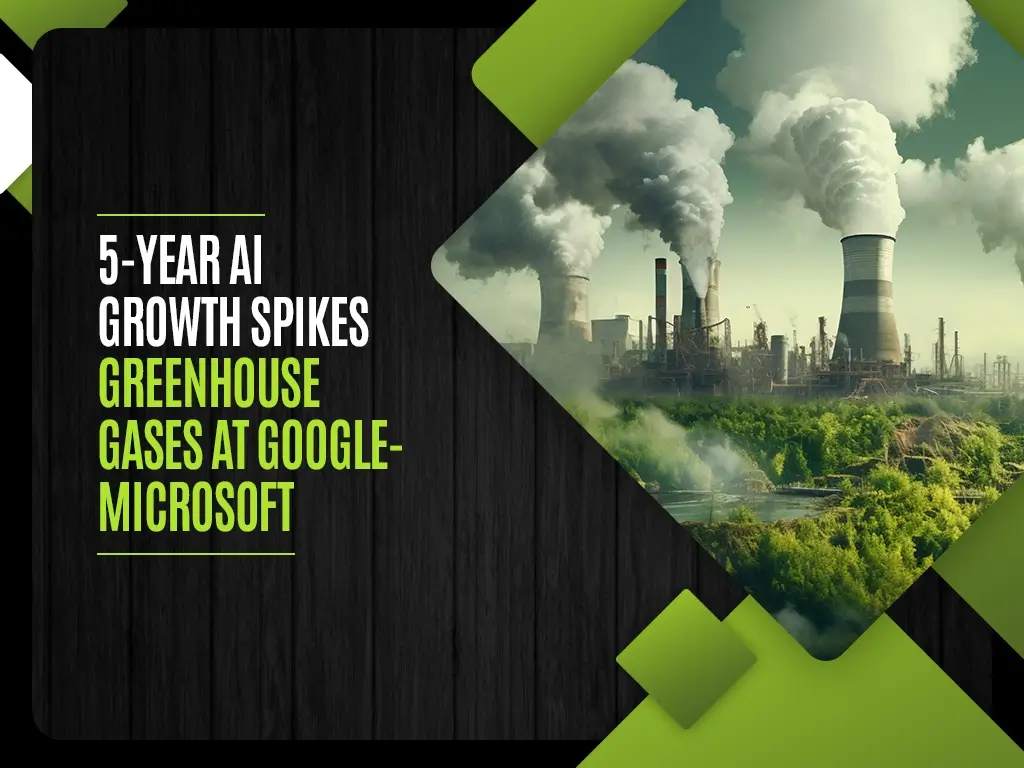5-Year AI Growth Spikes Greenhouse Gases at Google-Microsoft
Learn about the impact of AI for the rise of greenhouse gas emissions and the sustainability initiatives of Google and Microsoft.

Google’s greenhouse gas emissions rose by 50% over five years due to AI data centers, reaching 14.3 million metric tons in 2023.
AI integration led to a 17% increase in Google’s water usage for data center cooling, totaling 6.1 billion liters in 2023.
Tech companies like Microsoft also saw emission increases. Analysts warn of AI doubling US electricity demand growth, potentially exceeding supply in two years. Google expects a rise in emissions before a decline towards their 2030 carbon neutrality goal.
Google’s greenhouse gas emissions have surged by almost 50% in the past five years, primarily due to the energy demands of data centres supporting artificial intelligence (AI). Google’s 2024 Environmental Report, published on Tuesday, spotlighted this substantial increase. The report also outlines Google’s journey towards its 2030 carbon neutrality goal.
In 2023, Google disclosed that it emitted 14.3 million metric tons of carbon dioxide, marking a 48% increase since 2019 and a 13% rise from the previous year. The report attributes this steep increase to the escalating energy consumption of data centres and supply chain emissions. As AI becomes more ingrained in Google’s products, the challenge of reducing emissions intensifies due to the increased energy needs of the growing technical infrastructure.
Environmental Implications
The report highlights the environmental implications of the AI surge. Major tech companies like Google, Microsoft, Amazon, Meta, and Apple are investing heavily in AI. However, training AI models and using AI features requires vast amounts of energy. Research conducted in 2023 by AI startup Hugging Face and Carnegie Mellon University revealed that generating a single AI image can consume as much energy as charging a smartphone. Analysts at Bernstein have cautioned that AI could potentially double the rate of US electricity demand growth, possibly exceeding the current supply within the next two years.
Simultaneously, Microsoft, which has also pledged to become carbon-negative by the end of this decade, reported a nearly 30% increase in greenhouse gas emissions since 2020, largely due to the construction of data centres.
Rise in Water Usage
Google’s report also indicated a significant increase in water usage by its data centres, driven by the cooling requirements of expanded AI workloads. These workloads have included various applications, such as Google Search’s quirky suggestions and Gemini, the company’s AI-powered chatbot, which has been generating controversial content.
In 2023, Google’s data centres used 17% more water than the previous year, totalling 6.1 billion litres. This amount is sufficient to irrigate approximately 41 golf courses annually in the southwestern United States. Google acknowledged in its report that total greenhouse gas emissions are expected to rise before eventually declining towards the company’s emissions reduction target.
However, the report did not detail the factors that would contribute to this anticipated decrease. We note that predicting the future environmental impact of AI is complex and evolving. Historical trends may not fully capture AI’s future trajectory.
As AI becomes more deeply integrated across Google’s product portfolio, the distinction between AI and other workloads might become less significant.
This news is sourced.



